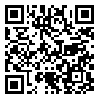Sat, Nov 30, 2024
[Archive]
Volume 18, Issue 4 (December 2021)
IJMSE 2021, 18(4): 1-10 |
Back to browse issues page
Download citation:
BibTeX | RIS | EndNote | Medlars | ProCite | Reference Manager | RefWorks
Send citation to:



BibTeX | RIS | EndNote | Medlars | ProCite | Reference Manager | RefWorks
Send citation to:
Abdulkhadar U M, Shivakumar Gouda P S, Shirahatti A, Veeresh Kumar G B, Banapurmath N R. Effect of Ply Orientation on Residual Stresses and Their Influence on Mode I Fracture Toughness of Glass-Epoxy Composites with 0°//0° Crack Interface. IJMSE 2021; 18 (4) :1-10
URL: http://ijmse.iust.ac.ir/article-1-2368-en.html
URL: http://ijmse.iust.ac.ir/article-1-2368-en.html
Umarfarooq Maktedar Abdulkhadar 
 , Patil Somalingana Shivakumar Gouda
, Patil Somalingana Shivakumar Gouda 
 , Anil Shirahatti
, Anil Shirahatti 
 , Gonal Basavaraja Veeresh Kumar
, Gonal Basavaraja Veeresh Kumar 
 , Nagaraj Ramalingyya Banapurmath
, Nagaraj Ramalingyya Banapurmath 


 , Patil Somalingana Shivakumar Gouda
, Patil Somalingana Shivakumar Gouda 
 , Anil Shirahatti
, Anil Shirahatti 
 , Gonal Basavaraja Veeresh Kumar
, Gonal Basavaraja Veeresh Kumar 
 , Nagaraj Ramalingyya Banapurmath
, Nagaraj Ramalingyya Banapurmath 

Abstract: (9173 Views)
The energy release rate for delamination in a laminated composite is supposed to be the material property being considered as independent of non-material property variables. However, Mode I fracture toughness(GI) is found to vary with lamina arrangement, geometrical dimensions, and process-induced stresses. In this investigation, the influence of lamina stacking arrangement on process-induced stresses and their effects on GI of laminated composites are studied. Unidirectional (UD) ([0]16) and cross-ply ([902/06]s, [904/04]s and [906/02]s) Glass/ epoxy (GE) composites with the delamination plane at 0◦//0◦ were prepared by manual layup method and post-cured at 120 °C for 4 hours. GI of composite laminates were experimentally determined using a double cantilever beam(DCB) specimen as per ASTM D 5528. The slitting method was applied to determine the Process-induced stresses in GE laminates. The stacking sequence of laminas was found to have a noticeable effect on the state of residual stresses and GI of GE laminates. Residual stresses do not have much influence on the GI for delamination initiation, whereas GI for the crack propagation was found to increase with a gradual increase in compressive residual stresses in GE laminates.
Type of Study: Research Paper |
Subject:
Ceramics
Send email to the article author
| Rights and permissions | |
 |
This work is licensed under a Creative Commons Attribution-NonCommercial 4.0 International License. |




